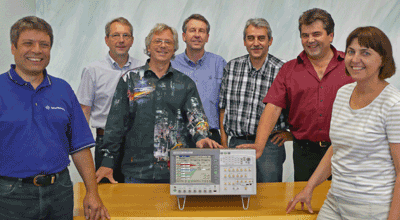Designed for now and the future: the J-BERT N4903B
In February 2009, Agilent Technologies introduced a high-performance serial BERT the J-BERT N4903B — that performs the most complete jitter-tolerance test for embedded and forward-clocked devices today. The instrument’s genesis dates to late 2007, when new serial buses were moving to speeds around 5 GHz and designers were faced with digital signal performance being more and more dominated by analog effects. At the time, engineers at the company’s Boeblingen, Germany, facility realized an instrument would be needed to support the new demands of advanced data-communication buses such as PCIe2.

According to Axel Wankmueller, R&D project manager for J-BERT, “As it often is with this kind of idea, quite a few people — system architects, engineers, marketing people — came together just talking over a good cup of coffee, and brought in their ideas of how to address these new requirements. One of the challenges was to develop a component which accurately could delay a data signal based on an external voltage.” This made it technically possible to build an instrument that could combine a BERT with calibrated, repeatable jitter injection. By changing the clock topology and reusing this component in the data and clock path it became possible to test forwarded and embedded clocking devices with the J-BERT N4903B.

Agilent Technologies’ J-BERT team (from left to right): Axel Wankmueller, J-BERT Project Manager; Heino Hoepke, R&D Software lead engineer; Michael Fleischer-Reumann, Strategic Product Planner; Dr. Josef Beller, R&D Engineer; Michael Goder, Procurement Engineer; Friedemann Gauss, Production Engineer; and Ellen Spindler, Product Manger Serial BERTs.
Like its predecessor, the J-BERT N4903A, the B version would be developed and tested with key customers. These companies, as well as participation in standards groups, would keep designers aware of changing requirements. Michael Fleischer-Reumann, strategic product planner for BERTs, notes another critical design goal: “When defining the J-BERT-B we had the protection of our customers’ investment in mind. We therefore not only created the possibility to upgrade from an existing J-BERT-‘A’ to a -‘B,’ but we defined J-BERT-B as a whole program….Once a customer has purchased the N4903B, he had already bought the basis for future enhancements” enabled only with software upgrades or hardware accessories. This phased-introduction approach was chosen because not all standards were stable enough to begin implementing the J-BERT in spring 2008.
Wankmueller recalls that, when the first prototype was built, “The challenge was: how can we make sure it accurately generates the desired type and amount of jitter?” As a result, the instrument’s performance relies on combining measurement theory with sophisticated calibration algorithms. “Watching the output signal of the J-BERT prototype and being able to adjust all the different jitter sources to the right values,” he says, “made us believe that it would be a great product.”
How well has the J-BERT B done in the market? According to Ellen Spindler, product manager for serial BERTs, “Despite a weak economy, we met our goals …. Customers liked [it] even more than we expected.”
Richard Comerford
Advertisement
Learn more about Agilent Technologies





